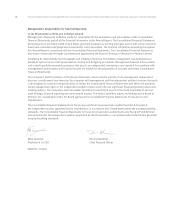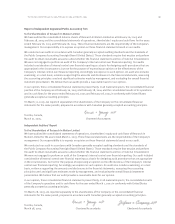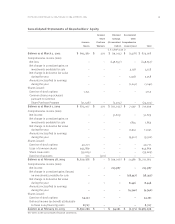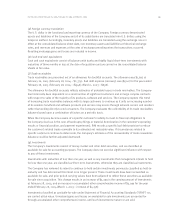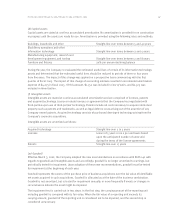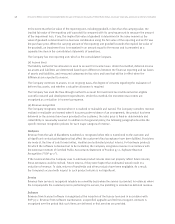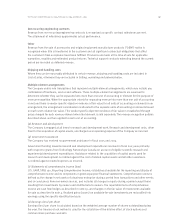Blackberry 2005 Annual Report Download - page 48
Download and view the complete annual report
Please find page 48 of the 2005 Blackberry annual report below. You can navigate through the pages in the report by either clicking on the pages listed below, or by using the keyword search tool below to find specific information within the annual report.
46
The Company monitors its investment portfolio for impairment on a periodic basis, and assesses declines
in the value of individual investments to determine whether the decline is other-than-temporary and thus the
investment is impaired. The Company makes this assessment by considering available evidence, including
changes in general market conditions, specific industry and individual company data, the length of time and
the extent to which the fair value has been less than cost, the financial condition and the near-term prospects
of the individual investment. In the event that a decline in the fair value of an investment occurs and the
decline in value is considered to be other-than-temporary, an appropriate write-down is recorded.
(h) Derivative financial instruments
The Company uses derivative financial instruments including forward contracts and options, to hedge
certain foreign currency exposures. The Company does not use derivative financial instruments for
speculative purposes.
The Company formally documents relationships between hedging instruments and associated hedged items.
This documentation includes: identification of the specific foreign currency asset, liability or forecasted
transaction being hedged; the nature of the risk being hedged; the hedge objective; and, the method
of assessing hedge effectiveness. Hedge effectiveness is formally assessed, both at hedge inception and on
an ongoing basis, to determine whether the derivatives used in hedging transactions are highly effective in
offsetting changes in foreign currency denominated assets, liabilities and anticipated cash flows of hedged items.
SFAS 133, Accounting for Derivative Instruments, as amended by SFAS 137, 138 and 149, requires all derivative
instruments to be recognized at fair value on the consolidated balance sheet, and outlines the criteria to be met
in order to designate a derivative instrument as a hedge and the methods for evaluating hedge effectiveness.
The fair value is calculated based on quoted market prices. For derivative instruments designated as fair value
hedges, changes in fair value are recognized in current earnings, and will generally be offset by changes in the
fair value of the associated hedged asset or liability. For derivative instruments designated as cash flow hedges,
the effective portion of changes in fair value are recorded in other comprehensive income, and subsequently
reclassified to earnings in the period in which the cash flows from the associated hedged transaction affect
earnings. Ineffective portions of changes in fair value, if any, are recorded in current earnings. If an anticipated
transaction is deemed no longer likely to occur, the corresponding derivative instrument is de-designated as a
hedge, and gains and losses are recognized in earnings at that time. Any future changes in the fair value of the
instrument are recognized in current earnings.
(i) Inventories
Raw materials are stated at the lower of cost and replacement cost. Work in process and finished goods
inventories are stated at the lower of cost and net realizable value. Cost includes the cost of materials plus
direct labour applied to the product and the applicable share of manufacturing overhead. Cost is determined
on a first-in-first-out basis.
(j) Impairment of long-lived assets
The Company reviews long-lived assets such as property, plant and equipment, and intangible assets with
finite useful lives for impairment whenever events or changes in circumstances indicate that the carrying
amount may not be recoverable. If the total of the expected undiscounted future cash flows is less than the
carrying amount of the asset, a loss, if any, is recognized for the excess of the carrying value over the fair value
of the asset.
Research In Motion Limited •Incorporated Under the Laws of Ontario (In thousands of United States dollars, except per share data, and except as otherwise indicated)




